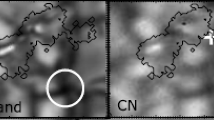Abstract
The evolution of the velocity and magnetic fields associated with supergranulation has been investigated using the Sacramento Peak Observatory Diode Array Magnetograph. The observations consist of time sequences of simultaneous velocity, magnetic field, and chromospheric network measurements. From these data it appears that the supergranular velocity cells may have lifetimes in excess of the accepted value of 24 hours. Magnetic field motions associated with supergranulation were infrequent and seem to be accompanied by changes in the velocity field. More prevalent were the slow dissipation and diffusion of stationary flux points. Vertical velocity fields of 200 m s−1 appear to be confined to downflows in magnetic field regions at supergranular boundaries. These downflows are only observed using certain absorption lines. Corresponding upflows in the center of supergranules of less than 50 m s−1 may be present but cannot be confirmed.
Similar content being viewed by others
References
Altrock, R., November, L., Simon, G., Milkey, R., and Worden, S. P.: 1975, Solar Phys. 43, 33.
Brault, J. W. and Testerman, L.: 1973, Preliminary Edition of the Kitt Peak Solar Atlas.
Chapman, G. A.: 1970, Solar Phys. 14, 315.
Chapman, G. A.: 1974, private communication.
Deubner, F. L.: 1972, Solar Phys. 17, 6.
Dunn, R. B., Rust, D. M., and Spence, G. E.: 1974, Proc. SPIE 44, 109.
Frazier, E. N.: 1970, Solar Phys. 14, 89.
Frazier, E. N.: 1974, Solar Phys. 38, 69.
Harvey, J. W. and Hall, D. N. B.: 1974, Bull. Am. Astron. Soc. 7, 459.
Leighton, R. B.: 1964, Astrophys. J. 140, 1559.
Leighton, R. B.: 1969, Astrophys. J. 156, 1.
Leighton, R. B., Noyes, R. W., and Simon, G. W.: 1962, Astrophys. J. 135, 474.
Livingston, W. C. and Orrall, F. Q.: 1974, Solar Phys. 39, 301.
Mullan, D. J.: 1971, Monthly Notices Roy. Astron. Soc. 154, 467.
Musman, S. and Rust, D. M.: 1970, Solar Phys. 13, 261.
Piddington, E. H.: 1975, preprint.
Rogers, E. H.: 1970, Solar Phys. 13, 57.
Rust, D. M. and Bridges, C. A., III: 1975, Solar Phys. 43, 129.
Simon, G. W. and Leighton, R. B., 1964, Astrophys. J. 140, 1120.
Simon, G. W. and Weiss, N. O.: 1968, Z. Astrophys. 69, 435.
Smithson, R. C.: 1973, Solar Phys. 29, 365.
Tanenbaum, A. S., Wilcox, J. M., Frazier, E. N., and Howard, R.: 1969, Solar Phys. 9, 328.
Wilson, P. R.: 1972, Solar Phys. 27, 363.
Author information
Authors and Affiliations
Rights and permissions
About this article
Cite this article
Worden, S.P., Simon, G.W. A study of supergranulation using a Diode Array Magnetograph. Sol Phys 46, 73–91 (1976). https://doi.org/10.1007/BF00157555
Received:
Issue Date:
DOI: https://doi.org/10.1007/BF00157555




